Diseases and pests of chrysanthemums: causes, symptoms, methods of struggle

Chrysanthemums are popular garden and indoor perennials, actively cultivated and very common in central Russia. Among their features, one can note the absence of the need for transplants, long and abundant flowering. They easily grow in one place for years, but this property often leads to the appearance of insects on the branches and the development of diseases for which novice growers are not at all ready.
Why do leaves curl and turn yellow? How to get rid of white rust on your home chrysanthemum? Is it possible to cope with the attack of pests in the garden at one time and how to cure the plant? All these issues require the most detailed consideration, because not only the chrysanthemum itself is under threat, but also its neighbors in the garden or home greenhouse.

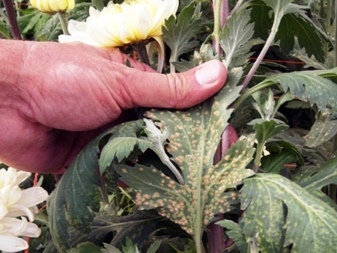
Causes
There can be many reasons for the development of chrysanthemum diseases - from the appearance of insect pests (such as thrips or aphids) on the site to the spread of fungal diseases. Often, infection occurs from neighboring plants, this is how powdery mildew spreads. Improper care can be attributed to frequent sources of problems, which contributes to the creation of favorable conditions for the appearance of root rot. What can lead to plant diseases?
Among the mistakes made by inexperienced growers are:
- excessively abundant soil moisture;
- stagnation of water at the roots due to poor drainage;
- too cold air;
- lack or excess of fertilizers;
- fungal infection of the planting material;
- introduction of fresh manure.
In addition to problems associated with improper farming practices, chrysanthemums often suffer from infections that are activated in favorable weather conditions. If aphids appear on the site, it is worth examining the neighboring plants. Especially often it affects greenhouse and greenhouse chrysanthemums.


Symptoms
What should you pay attention to, how to diagnose the appearance of diseases and pests? It is worth regularly inspecting the plant, do not neglect caring for it. Symptoms of parasitic insect infestation on chrysanthemums most often look like this.
- With thrips, dots or spots appear on the leaves, then they turn yellow, discolor, wither, dry and fall off. The insect itself is small, with an elongated body, juveniles are yellow-beige, adults with glossy black backs, winged. You can look for them on the back of the leaves.
- With leaf nematode leaves are covered with spots of yellow-brown color, gradually growing over the entire surface. The foliage first dies off and curls up in the lower part of the stem, then the upper shoots die. Infected bushes are destroyed.
- Symptoms can vary with aphids., depending on the type of the pest itself. Most often, the inflorescence of a plant is affected by the brown subtype, which leaves traces of its vital activity inside. The pests look like small dark brown or black beetles. The greenhouse aphid is pink or green in color, is located in colonies on the stem or in the lower part of the leaf, sucks out juices, leading to wilting and death of the flower.
- With spider mite infestation on the leaves on the reverse side you can see traces of cobwebs, the leaves of the plant dry, the shoots wither and turn yellow. In hot weather, the parasite is especially active.
- When leafhoppers or slobbery pennits appear foamy traces of insect activity appear on the plant.It feeds exclusively on flower sap.
- When meadow bugs attack, the buds disappear, they are deformed, like the shoots, and the development of the chrysanthemum is disrupted.
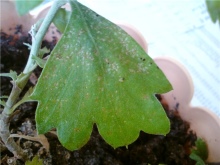
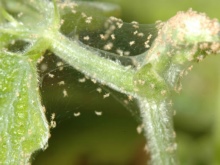

Plant diseases
Infectious lesions manifest themselves in different symptoms. Most often, the buds disappear, growth stops, the foliage withers, the roots rot and die off, spots atypical for their color appear on the shoots.
The following fungal infections are considered the most common.
- White rust. With this disease, the leaves are covered with rounded yellow spots with a diameter of no more than 5 mm. A whitish bloom forms on the back of the leaves. When the disease spreads, the lesion also affects the petals of the flower.
- Powdery mildew. An infectious disease in which a bloom similar to scattered flour forms on the entire surface of the chrysanthemum bush. Plants that do not receive potassium supplements are at risk.
- Gray rot. It looks like mold sprinkled on foliage. Spots with a watery structure cover all the shoots of the plant in the above-ground part. In dense plantings, spread is very fast. Affected plants are destroyed.
- Fusarium. With this disease, the leaves of the plant curl, rot forms on the stem, and the root dries up.
- Septoria. It is characterized by damage to the leaves, on the surface of which the spores of the fungus leave yellow-brown spots. The disease develops on the lower shoots, may be associated with thickening of plantings, poor harvesting of fallen leaves.
- Rust. With this disease, a rusty coating forms on the surface of the leaves, which quickly spreads throughout the bush. On the reverse side, the shoots are covered with rounded heaps of dark brown color. The problem mainly arises in greenhouse and greenhouse plants, house chrysanthemums in pots.
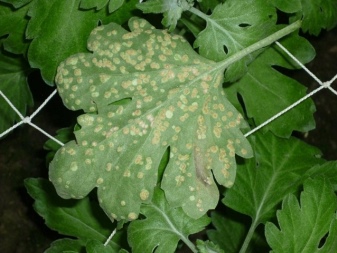
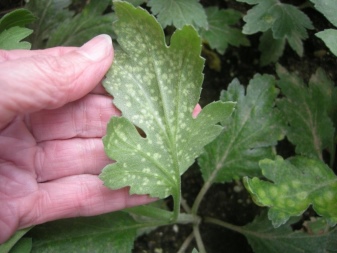
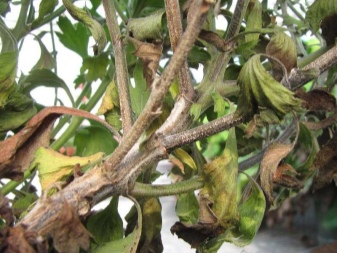

Root bacterial cancer is considered a rare but dangerous disease for chrysanthemums. When it appears on the stems, deforming growths are formed, they also affect the root system. All infected bushes are subject to mandatory destruction.
Chrysanthemum is quite resistant to viral diseases, but signs of mosaicism, white spot or dwarfism can also appear on it. There are also non-infectious problems. For example, fragility, stem cracking associated with excessive watering.
When moisture stagnates at the root, it also begins to rot, the shoots of the plant wither, lose their color brightness, and stop growing and blooming. When red streaks appear on the leaves, it can be understood that the flower has suffered from frost, so it needs shelter.
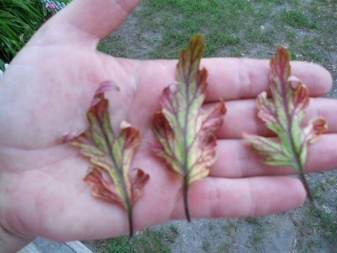
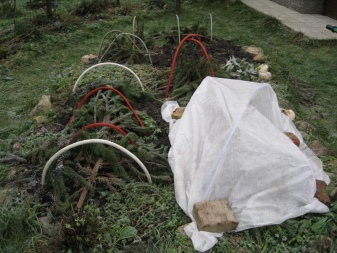
Control methods
What treatment is recommended for different diseases of chrysanthemums? There are general rules for certain groups of diseases. With fungal infections, the first step is to remove all affected plant parts. They must be destroyed by burning. Fight against the disease with fungicides begins if the disease spreads rapidly. To get rid of fusarium in the soil helps to regulate its acidity to 7 pH.
Among the most popular formulations for combating fungal infections are:
- 1% solution of colloidal sulfur;
- Bordeaux liquid;
- copper preparations;
- Fundazol.
At home, flower growers are most often faced with mosaic - a viral disease that causes dwarfism, shredding of flowers, yellowing of foliage. You can get rid of it by removing the already affected areas, replanting the plant and ridding it of weeds. If possible, the plants affected by the mosaic are destroyed or discarded without taking cuttings from them for propagation.
If powdery mildew appears on the plants - a white bloom, similar to dusting, you should not hesitate. Usually, the disease manifests itself against the background of a lack of nitrogen-potassium fertilizers in the soil. First, treatment is performed using a soda ash solution on a soap base. For 10 liters of water, take 40 g of each substance.
If this does not help, a solution of copper sulfate is used.
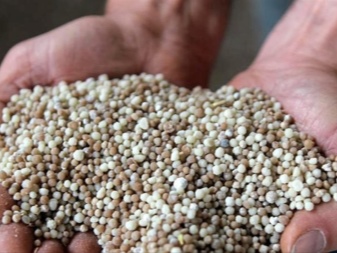
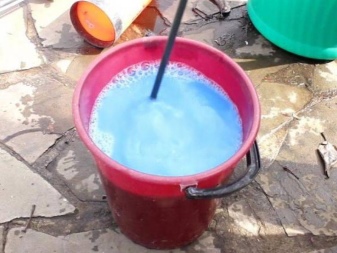
With insects
When affected by nematodes - roundworms that destroy plants, the main sources of danger are soil, humus, and burning foliage. Recommended plant rescue measures are related to spring mulching. Sometimes a solution of insecticidal soap or the drug "Heterophos" helps to revive the leaves. You need to spray the entire bush, trying to process it as efficiently as possible. If this measure does not help, the plant, together with the earthen clod, is dug up and destroyed.
The fight against aphids is of greatest interest to summer residents. Since these pests affect not only chrysanthemums, a wealth of experience has been accumulated in this area. Among the most popular means to help destroy aphids are the following.
- Mechanical treatment of all parts of the plant with soapy water. The procedure is performed with gloves, using a soft sponge. Relevant if aphids have appeared recently.
- Chemical pest control. It is performed using the preparations "Karbofos", "Phosphamide", "Metaphos" on a phosphate basis. The solution is prepared at the rate of 20 ml of liquid per 10 liters of water. Processing is carried out at calm hours, in the morning or in the evening, using a sprayer, with the obligatory spraying of the soil in the root zone.
- Using ammonia. For this, an aqueous solution is prepared in a proportion of 100 ml per 1 liter of water, spraying is repeated every 12 days until the pests are completely destroyed. Work is performed in a respirator.
- Folk remedies. Most often these are infusions, for example, 20 g of onion peel per 1 liter of water. The resulting composition is sprayed with chrysanthemums. The procedure is repeated three times, every 10 days. A concentrated solution of tar or laundry soap also helps. It is applied to the places of the greatest accumulation of insects.
- Planting plants that are natural enemies of aphids. Pelargonium possesses these properties.
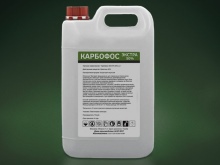

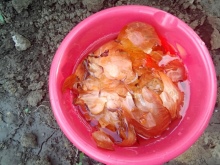
You can also fight the spider mite with the help of prevention and treatment measures. It is important to deprive him of opportunities for comfortable wintering by destroying autumn debris, heaps of prevailing foliage, and digging up the top layer of soil. If the pest has already appeared, it is worth using sulfur powder or its colloidal 1% solution in a volume of 100 g per 10 liters of water. The composition is applied so that it falls on the lower part of the sheet, with three repetitions, every 10 days.
Preventive measures
In order to prevent the development of diseases and pest attacks on domestic or garden chrysanthemums, just follow a few simple rules.
- Thoroughly weed and loosen the soil. This will avoid stagnation of root moisture, provide good growing conditions.
- Avoid applying fresh manure. It can cause burns to the roots, severely damage the plant.
- Water with extremely moderately warm water, it is better if it is at room temperature.
- Apply potash and phosphorus-based fertilizers regularly. Top dressing should take place in liquid form every 10 days. No fertilizer is applied during the flowering period.
- Observe the distance when landing, when it comes to growing chrysanthemums in the garden. It is not necessary to thicken them, otherwise the risks of developing diseases will be significantly increased.
- Carry out preventive spraying with Bordeaux liquid 10 days after planting. Before sending to the ground, cuttings must be treated with a solution of "Fundazole" to prevent fungal infections.
- Indoor chrysanthemums up to 3 years old need to be replanted annually. At an older age - once every 2 years.

Be sure to thoroughly clean your garden in the spring and fall. It is in the fallen foliage that pests live, capable of causing serious harm to plantings in spring. Under the chrysanthemums themselves, you also need to remove the fallen parts of the plant.
How to grow and treat chrysanthemum, see below.







































































































The comment was sent successfully.